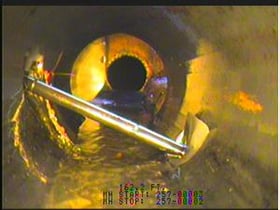 Gas line cross bores are a huge danger lurking underground. With the popularity of trenchless construction methods and the prevalence of legacy cross bores, locating and eliminating them is critical to preventing potentially deadly explosions. Full lateral inspections using a lateral launch crawler are advised where legacy cross bores are a risk, and wherever new HDD gas line installation is completed. Learn about preventing, detecting and repairing cross bores with this curated selection of expert articles:
Gas line cross bores are a huge danger lurking underground. With the popularity of trenchless construction methods and the prevalence of legacy cross bores, locating and eliminating them is critical to preventing potentially deadly explosions. Full lateral inspections using a lateral launch crawler are advised where legacy cross bores are a risk, and wherever new HDD gas line installation is completed. Learn about preventing, detecting and repairing cross bores with this curated selection of expert articles:
- “Preventing Cross-Bore Disaster,” Ted DeBoda. Municipal Sewer & Water. Cross bores, particularly of gas lines, must be located and repaired. NASSCO’s PACP and LACP can help. These reporting standards ensure that data is reliable and consistent and can be transferred easily among asset management systems. The standards also have specific defect codes for cross bores, alerting all stakeholders to their presence. The author of this article, Ted DeBoda, is the Executive Director of NASSCO, the creator of PACP and LACP.
- “Preventing and Eliminating Cross Bores - Increasing Safety and Reducing Risk,” Mark Bruce. Cross Bore Safety Association. The best way to prevent cross bore disasters is to avoid creating cross bores to begin with. Taking steps to ensure that you know where laterals are, and then performing post-drilling inspections is key. This article by Mark Bruce, the President of the Cross Bore Safety Association, details the main methods for preventing cross bores.
- “How to Locate a Lost Sewer,” Peter Morici. Cleaner Magazine. Knowing where laterals are is vital to preventing cross bores while directional drilling. Occasionally, other utility lines and similar metallic objects underground can hinder locators. This article addresses locating laterals for construction and repair bids, although the steps are relevant for pre-HDD site assessment. Through the steps detailed in this article, you can find out where exactly a pipeline is and how deep it runs.
- “Raising Awareness and Preventing Cross Bores,” Distribution Contractors Association. Trenchless Technology. Similar to the piece by the Cross Bore Safety Association, this article details the steps necessary to prevent cross bores—listing steps for contractors, gas utilities and different levels of government to follow.
- “Digging Deep: The Growing Market for Cross Bore Inspection Services.” Envirosight. Cross bore detection isn’t always performed directly by utilities. Contractors in the sewer inspection industry have a huge opportunity to grow their business by contracting cross bore locating services to utilities. This white paper presents some of the commercial considerations driving the market for cross bore location services.
The ROVVER X SAT lets you inspect laterals from a mainline, ideal for finding dangerous gas line cross bores and illicit flows. The system integrates with your existing ROVVER X system components, reducing cost and equipment clutter. Best of all, ROVVER X SAT gives you the range and articulation to inspect where other lateral launch systems can’t. Schedule a FREE on-site demo to learn more about ROVVER X SAT:
*Cross bore photo from Compliance Envirosystems. CES brings accuracy and skill in finding, resolving, and preventing cross bores. In fact, CES participated in developing the Specification Guideline for Cross Bore Prevention & Detection by the National Association of Sewer Service Companies. Visit https://www.ces-sses.com/services/cross-bore-locating/crossbore-locating/ to learn more.

